
U.S. Geological Survey Fact Sheet 172-96
Online Version 2.0
Invisible CO2 Gas Killing
Trees at Mammoth Mountain, California
|
Since 1980, scientists have monitored geologic
unrest in Long Valley Caldera and at adjacent Mammoth
Mountain, California. After a persistent swarm of earthquakes
beneath Mammoth Mountain in 1989, geologists discovered
that large volumes of carbon dioxide (CO2
) gas were seeping from beneath this volcano.
This gas is killing trees on the mountain and
also can be a danger to people. The U.S. Geological
Survey (USGS) continues to study the CO2
emissions to help protect the public from this invisible
potential hazard. |
Mammoth Mountain
is a young volcano on the southwest rim of Long Valley Caldera, a large
volcanic depression in eastern California. The Long Valley area, well
known for its superb skiing, hiking, and camping, has been volcanically
active for about 4 million years. The most recent volcanic eruptions
in the region occurred about 200 years ago, and earthquakes frequently
shake the area. Because of this, the U.S. Geological Survey (USGS)
operates an extensive network of instruments to monitor the continuing
unrest in the Long Valley area.
Numerous small
earthquakes occurred beneath Mammoth Mountain from May to November 1989.
Data collected from monitoring instruments during those months indicated
that a small body of magma (molten rock) was rising through a fissure
beneath the mountain. During the next year, U.S. Forest Service rangers
noticed areas of dead and dying trees on the mountain. After drought
and insect infestations were eliminated as causes, a geologic explanation
was suspected. USGS scientists then made measurements and discovered
that the roots of the trees were being killed by exceptionally high concentrations
of carbon dioxide (CO2) gas in the soil. Today, areas of dead
and dying trees at Mammoth Mountain total more than 100 acres. The
town of Mammoth Lakes, just east of this volcano, has not been affected.
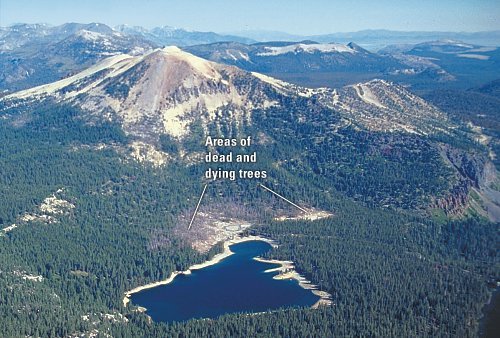
|
|
Mammoth Mountain, a young volcano in eastern
California, sits on the southwest rim of Long Valley
Caldera. In 1994, scientists detected high concentrations
of CO2 gas in the soil on Mammoth Mountain.
This invisible gas, seeping from beneath the volcano,
is killing trees on the sides of the mountain and
can pose a threat to humans. Recent
measurements indicate that the total rate of CO2
gas emission at Mammoth Mountain is close to 300 tons
per day. In this photo, large areas of dead and dying
trees are visible near Horseshoe Lake, on the southeast
flank of Mammoth Mountain. (Copyrighted photo
courtesy of John D. Rogie.) |
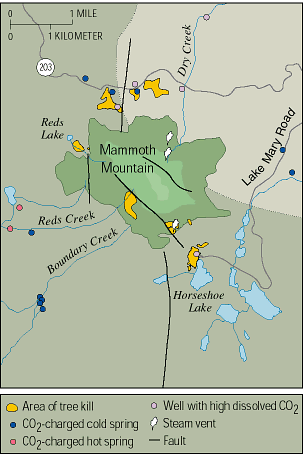
|
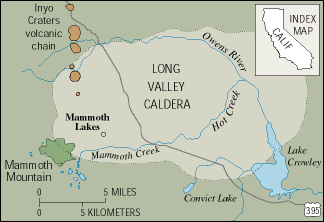
Areas of
dead and dying trees at
Mammoth Mountain volcano
total more than 100 acres.
In 1990, the year after a persistent
swarm of small earthquakes occurred
beneath the volcano, U.S.
Forest Service rangers
first noticed areas of tree
kill. When U.S. Geological
Survey scientists investigated,
they discovered that the trees
are being killed by high
concentrations of
CO2 gas in the
soil. The seepage of CO2
gas from below Mammoth Mountain
and the continued occurrence of
local earthquakes are signs
of the ongoing geologic
unrest in the area. The
upper part of the
11,053-foot-high volcano (above
9,500 feet) is shown in darker shades
of green (map, top
right).
|
|
Although leaves of plants produce oxygen (O2) from
CO2 during photosynthesis, their roots need to absorb O2
directly. The high CO2 concentrations in the soil on Mammoth
Mountain are killing trees by denying their roots O2 and
by interfering with nutrient uptake. In the areas of tree kill, CO2
makes up about 20 to 95% of the gas content of the soil; soil gas
normally contains 1% or less CO2.
When CO2
from soil leaves the ground, it normally mixes with the air and dissipates
rapidly. CO2 is heavier than air, however, and it can collect
at high concentrations in the lower parts of depressions and enclosures,
posing a potential danger to people. Breathing air with more than 30%
CO2 can very quickly cause unconsciousness and death.
Therefore, poorly ventilated areas above and below ground can be dangerous
in areas of CO2 seepage. Where thick snowpacks accumulate
in winter, the CO2 can be trapped within and beneath the snow.
Dangerous levels of CO2 have been measured in pits dug in
the snowpack in tree-kill areas on Mammoth Mountain, and snow-cave camping
in such areas is not advised.
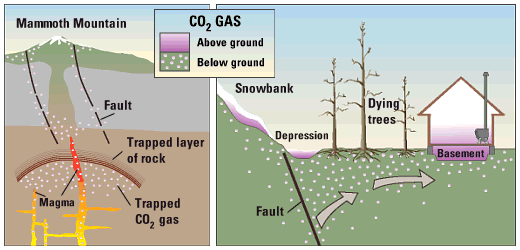
|
|
CO2 gas seeping from the ground at
Mammoth Mountain is likely derived from magma (molten
rock) beneath the volcano. In 1989, rising magma may
have opened cracks, allowing large amounts of trapped
CO2 gas to leak upward along faults. High
concentrations of CO2 in soil can kill the
roots of trees. CO2 gas is heavier than air,
and when it leaks from the soil, it can collect
in snowbanks, depressions, and poorly
ventilated enclosures, such as cabins and tents, posing
a potential danger to people. |
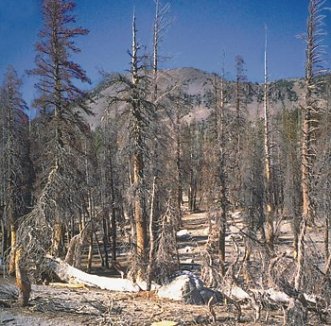
|
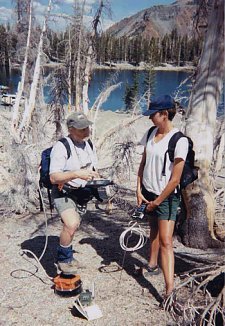
|
|
In 1989?90,
trees in this area on the south side
of Mammoth Mountain volcano began dying
from high concentrations of
CO2 gas in the soil.
Although leaves of plants
produce oxygen (O2)
from CO2 during photosynthesis,
their roots need to absorb O2
directly. High CO2
concentrations in the soil kill
plants by denying their roots
O2 and by
interfering with nutrient uptake. In
the areas of tree kill at Mammoth Mountain,
CO2 makes up about
20 to 95% of the gas content of
the soil. Inset (right photo)
shows scientists measuring soil
gas in this area. |
|
Geologists have detected CO2 emissions, like those
at Mammoth Mountain, on the flanks of other volcanoes, including Kilauea
in Hawaii and Mount Etna in Sicily. Measuring the total rate of CO2
gas emissions on the flanks of volcanoes or within calderas is difficult
and labor intensive and is commonly done using portable infrared CO2
detectors.
Recent measurements
at Mammoth Mountain indicate that the total rate of CO2 gas
emission is close to 300 tons per day. This value varies on both short
(days to weeks) and long (months to years) time scales because of changes
in atmospheric conditions and in the rate at which gas is being released
from beneath the volcano.
Past eruptions
at Mammoth Mountain, such as the phreatic (steam blast) eruptions that
occurred about 700 years ago on the volcanoís north flank, may have been
accompanied by CO2 emissions. Scientists think that the current
episode of high CO2 emissions is the first such activity
on the mountain for at least 250 years because the oldest trees in the
active tree-kill areas are about that age. Carbon-isotopic analyses of
the annual growth rings in trees near the margins of the tree-kill areas
imply that the gas-emission rate reached a peak in 1991, subsequently
declined, and then has been relatively stable since about 1996.
CO2 and
other volcanic gases, like helium, seeping from Mammoth Mountain appear
to be leaking from a large reservoir of gas supplied by repeated intrusions
of magma. Tree-ring evidence from near springs on the mountainís flanks
shows that some CO2 gas was leaking before 1989 and dissolving
in the ground-water system. It is likely that the latest intrusion
of magma (in 1989) opened deep fractures, increasing the rate of gas
seepage.
The continuing
occurrence of small earthquakes and CO2 seepage beneath Mammoth
Mountain are only two of the many signs of volcanic unrest in the area.
Earthquakes and ground uplift are also occurring within the central part
of Long Valley Caldera, only a few miles east of Mammoth Mountain, and
the Mono-Inyo Craters volcanic chain to the north has had small volcanic
eruptions every few hundred years for the past 4,000 years.
Scientists with the
USGS Volcano Hazards Program are closely monitoring CO2
emissions and other geologic hazards at Mammoth Mountain. The work of
these scientists is only part of the USGS Volcano Hazards Programís
ongoing efforts to protect peopleís lives and property in all of the
volcanic regions of the United States, including the Pacific Northwest,
Alaska, Hawaii, and Arizona.
Michael L. Sorey,
Christopher D. Farrar, Terrance M. Gerlach, Kenneth A. McGee,
William C. Evans, Elizabeth M. Colvard, David P. Hill, Roy A. Bailey,
John D. Rogie, James W. Hendley II, and Peter H. Stauffer
Graphic design
by
Susan
Mayfield and Sara Boore
Banner design
by Bobbie Myers
COOPERATING
ORGANIZATIONS
Mammoth
Mountain Ski Area
Town of
Mammoth Lakes
U.S.
Department of Agriculture, Forest Service
Pennsylvania
State University
For more information
contact:
Earthquake
Information Hotline (650) 329?4085
U.S.
Geological Survey, Mail Stop 977
345
Middlefield Road, Menlo Park, CA 94025
Related Fact
Sheets
Living With a Restless Caldera - Long Valley,
California (USGS Fact Sheet 108?96)
Future Eruptions in Californiaís Long
Valley Area - What ís Likely? (USGS Fact Sheet 073?97)
U.S. GEOLOGICAL SURVEY REDUCING THE RISK FROM VOLCANO
HAZARDS
Download a
PDF version of this fact sheet (1.43
Mb)
URL of this page:
https://pubs.usgs.gov/fs/fs172-96/
Maintained by:
Michael Diggles







